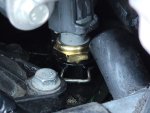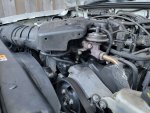mister moose
New Member
- Joined
- Jan 16, 2014
- Messages
- 22
- Reaction score
- 7
- Points
- 3
- Location
- NW CT
- Vehicle Year
- 2011
- Make / Model
- Ford Ranger
- Engine Type
- 4.0 V6
- Engine Size
- 4L
- Transmission
- Manual
- 2WD / 4WD
- 4WD
- Total Lift
- None
- Total Drop
- None
- Tire Size
- OEM
- My credo
- Never work on a powder day.
I didn't see this anywhere else, and thought I'd pass it along.
2002 4.0L V6, 145,000 miles
My symptoms were -
Slightly low engine temp
Erratic high idle once in a while
Check Engine light with codes 118 and 125
Which lasted over a year, no big deal.
Then it degraded to hard starting, flooding, wouldn't stay running, then would after 5 minutes of coaxing. Time to fix it.
When you need to replace the coolant temp sensor, I learned the following:
Mine would not come out due to low height of the intake manifold. I had to loosen the front 10 cap screws (out of 12) to get enough room to get the sensor out. I did not need to remove the manifold, a half inch wobble is all you need. A T30 Torx bit on a long extension will be needed. 1/4" drive as the holes aren't large enough for 3/8 drive.
Mine was the clip style, not threaded. Removing the clip was problematic. I couldn't get needle nose piers to work, nothing else seemed remotely able to grab it in such close quarters. Then the light bulb went off. A paint can opener. Those little J hooked thingies. The hook was too thick to fit in, but a few seconds on a grinder to thin it down and voila, clip out. While we're on clips, DO NOT DO NOT DO NOT lose it. Both the Dealer and NAPA had no clips. The new sensor does not come with one. (Seriously?)
A little prying and cursing and out it comes. Mine needed to tilt forward as it came out.
Going back in, it's tight, and you have nowhere near enough strength in your fingertips. Vaseline made a huge difference, it didn't go in with glycerin. Don't even think about putting it in dry. Place the wire harness on first before installing.
While you're there, give serious thought to replacing the thermostat. The housing cover has to come off anyway, unless you removed the entire intake manifold.
There's some YouTube videos that cover the rest, but don't cover the above.
Immediately after sensor replacement all of the above symptoms were gone...
2002 4.0L V6, 145,000 miles
My symptoms were -
Slightly low engine temp
Erratic high idle once in a while
Check Engine light with codes 118 and 125
Which lasted over a year, no big deal.
Then it degraded to hard starting, flooding, wouldn't stay running, then would after 5 minutes of coaxing. Time to fix it.
When you need to replace the coolant temp sensor, I learned the following:
Mine would not come out due to low height of the intake manifold. I had to loosen the front 10 cap screws (out of 12) to get enough room to get the sensor out. I did not need to remove the manifold, a half inch wobble is all you need. A T30 Torx bit on a long extension will be needed. 1/4" drive as the holes aren't large enough for 3/8 drive.
Mine was the clip style, not threaded. Removing the clip was problematic. I couldn't get needle nose piers to work, nothing else seemed remotely able to grab it in such close quarters. Then the light bulb went off. A paint can opener. Those little J hooked thingies. The hook was too thick to fit in, but a few seconds on a grinder to thin it down and voila, clip out. While we're on clips, DO NOT DO NOT DO NOT lose it. Both the Dealer and NAPA had no clips. The new sensor does not come with one. (Seriously?)
A little prying and cursing and out it comes. Mine needed to tilt forward as it came out.
Going back in, it's tight, and you have nowhere near enough strength in your fingertips. Vaseline made a huge difference, it didn't go in with glycerin. Don't even think about putting it in dry. Place the wire harness on first before installing.
While you're there, give serious thought to replacing the thermostat. The housing cover has to come off anyway, unless you removed the entire intake manifold.
There's some YouTube videos that cover the rest, but don't cover the above.
Immediately after sensor replacement all of the above symptoms were gone...
Last edited:
















